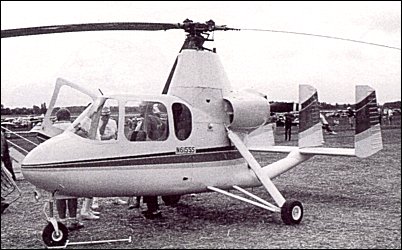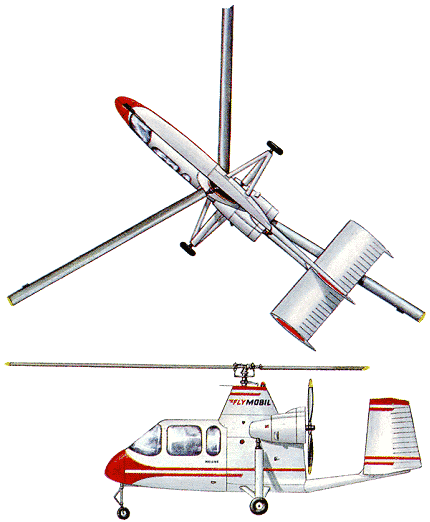
| Air & Space 18A "Flymobil" 200? |  |
 |

| Air & Space 18A "Flymobil" 200? |  |
 |
|
This attractive little jump-start autogyro was designed by Raymond Umbaugh in 1959 after he had built and sold several examples of single-seat cabin developments of the Bensen Gyro-Copter. The Umbaugh 18 prototype (N43U) was flown during 1959, and in August arrangements were made for final development and mass production to be undertaken by Fairchild, the aircraft to be known as the Flymobil. In the event, however, Fairchild built only five development aircraft during 1960, all being tandem 2-seaters with 180hp Lycoming O-360-A1D engines. The original single fin and rudder of the first prototype gave way first to a Vee tail assembly and finally to a triple tail unit with a low-set tailplane bearing two fixed fins and a third movable one in the centre. One of the Fairchild machines was used to gain an FAA type approval certificate in September 1961, and certification of the production version, the Model 18-A, was granted early in 1965. This is built by the Air & Space Manufacturing Co. of Indiana, the agreement with Fairchild meanwhile having been dissolved. No recent figures have been disclosed, but one hundred and ten production Model 18-A's had been completed by the end of 1965. The autogyro has an all-metal fuselage skin, and wooden rotor blades reinforced with glassfibre. The engine drive can be connected to the rotor for jump starts, after which it is disengaged and clutched to the pusher propeller for forward movement. K.Munson "Helicopters And Other Rotorcraft Since 1907", 1968 
The U-17 gyrocopter was the brainchild of Raymond E. Umbaugh, an agricultural fertilisers manufacturer and enthusiast for the unique properties of autogyros. His U-17 design was a tandem two-seat machine with a slim low-set tailboom and a single fin and tiny T-tailplane. The prototype was built for Umbaugh by the Fairchild Engine & Airplane Corporation at Hagerstown, Maryland. It made its first flight in mid- 1959 and was powered by a 195kW Lycoming engine. The second prototype, designated U-18, was redesigned to eliminate the fairly unsatisfactory stability problems of the first prototype. This aircraft was fitted with a 135kW Lycoming 0-360 and, initially, with a V-tail. The stability problems were still not resolved, however, and a new triple tail with a central rudder was installed. This improved the Umbaugh to the point where it was awarded its Type Certificate (1H 17) on 12 September 1961. Ray Umbaugh embarked on an ambitious plan to market the U-18, placing an order for 10000 units with Fairchild. A large network of dealers and distributors was set up in the United States but Umbaugh started to run into trouble because the manufacturing output of the U-18 was too slow to meet the demands of dealers for demonstration aircraft. The dealers, who had paid large franchise fees took over Umbaugh, the agreement with Fairchild was terminated and manufacturing moved to Florida. The company finally collapsed with just four aircraft completed and flown. The design was then acquired by Air & Space Manufacturing of Muncie, Indiana which made some modifications to the tail unit and commenced manufacture of the Air & Space 18A. Again, Air & Space was faced with dealer pressure for aircraft and set out to raise capital for expansion. This funds-raising exercise resulted in accusations from the Securities & Exchange Commission of irregularities in the commercial claims made to new investors and, though the company's management was eventually cleared of wrongdoing, the costs and delay resulted in the company's collapse. A total of 99 production aircraft had been registered though only 67 of these appear to have been actually completed. The assets of Air & Space then went into storage but were eventually reinstated by one of the dealers, Don Farrington of Paducah, Kentucky. Lacking the rights to the type certificate, Farrington Aircraft set up a programme to remanufacture existing aircraft with a modified collective pitch system, fibreglass engine cowlings and new composite blades. Farrington has also developed an amateur-built kit gyrocopter with some features of the U-18 known as the Farrington "Twinstar". This has an open fibreglass cockpit shell, a large twin-fin tail unit and a main rotor mounted on a tubular steel pylon. It is powered by a 110kW Lycoming 0-320 and the first prototype first flew in 1993. R.Simpson "Airlife's Helicopter and Rotorcraft", 1998
|